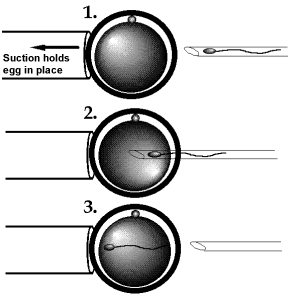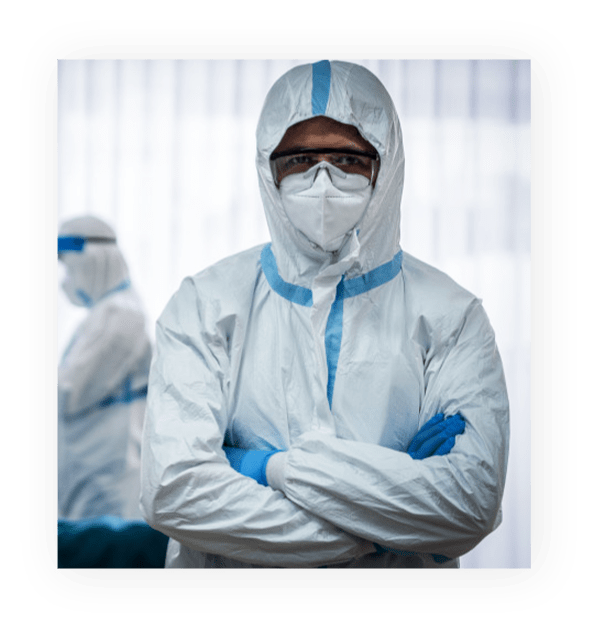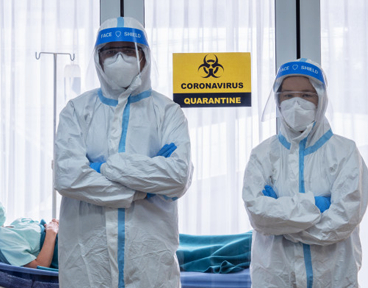Intra-Cytoplasmic Sperm Injection (ICSI)
Male-factor infertility occurs in approximately 40% of couples who are unable to achieve a pregnancy. Severe male-factor infertility accounts for 25% of infertility. Less than 10% of male infertility can be successfully treated with surgical or medical therapies.
Intra Cytoplasmic Sperm Injection (ICSI) is the most recent advance of ART to have happened in the world. It was discovered as recently as 1993 and has revolutionized the ART World.
The technology is a boon for couples where there is severe oligo asthenozoospermia (OATS – scanty sperm numbers with poor motility). It is also useful in certain other cases of infertility where it yields better results than IVF.
If there are even small number of sperm in the ejaculate, sperm can be taken from a semen sample for ICSI. If there are no sperm in the ejaculate, due to an obstruction or to very low sperm production, or if sperm are affected severely by antisperm antibodies during their maturation process, sperm can now be surgically retrieved directly from the testis (TESE) or epididymis(ESA). Because it is the genetic information carried in the head of the sperm that needs to get into the egg, immature sperm whose tails have not fully developed are adequate for use in ICSI.
To perform successful ICSI one needs to have not only tremendous expertise but also hi-tech equipment that is made by latest precision technology.
Why ICSI?
ICSI is indicated when there are not enough normal, motile sperm for intrauterine insemination or standard IVF.
Cases when the sperm sample has lot of morphologically abnormal sperms.
Sperm samples with poor sperm motility.
Advanced age of female partner (Where fertilization rates with conventional IVF can be low)
It is also used frequently when there are poor fertilization results in previous IVF cycles.
Where the male partner is unavailable on the day of actual procedure (OPU) and the frozen sperm sample needs to be used for fertilization ICSI is always a better option.
This technique does not require large numbers of motile sperm and bypasses the need for the sperm to penetrate the egg by itself. It is a micromanipulation technique originally developed in Belgium. By using a powerful microscope we are able to isolate a single sperm, aspirate it into an extremely thin glass pipette and inject it into a single egg.
With the help of ICSI, fertilization is achieved and embryos that continue to divide are ready for transfer into the uterus.
No increase in congenital anomalies (birth defects) has thus far been observed with ICSI.
ICSI has better success rate than IVF, though the results vary with female age.
Procedure of ICSI

This procedure is very specialized and requires a great deal of skill on the part of the scientist. All the procedures require the use of special microscopes and micromanipulation equipment. To put it in perspective, an egg is just one tenth of a millimeter across. Yet it appears huge in comparison with the injected sperm at the tip of the needle-like injecting pipette.
The egg is gently held with a suction pipette, while a sperm is picked up with the microinjection pipette and deposited in the cytoplasm of the egg. By doing this, several barriers to the sperm have been removed and fertilization usually follows.
The day after injection, we can tell that fertilization has taken place if there are two small spheres (Pronuclei) visible in the egg. If fertilization is successful, the early embryo or zygote is allowed to divide in culture medium in laboratory for 3-5 days, before it is transferred to the uterus or fallopian tube. Any spare, good quality embryos resulting from the procedure can be frozen for more attempts later.
About PESA/TESA
Epididymal sperm aspiration (PESA) and testicular sperm extraction (TESE) are recently developed procedures for overcoming extreme male infertility. Very low or zero sperm counts, and sperm severely affected by antisperm antibodies, can be overcome by these methods. The sperms are obtained directly from the testis or ducts leading from the testis, before they risk much damage from oxidation or are exposed to antisperm antibodies in the epididymis or vas deferens. For azoospermia (complete absence of sperm) caused by failure of sperm to mature, TESE is able to make use of immature sperm for ICSI.
How Are They Done?
TESE : This procedure can be used for instances where sperm production is a problem (non-obstructive azoospermia) or where there is an obstruction to sperm flow(obstructive azoospermia).Obstructive azoospermia can be due to congenital absence of vas deferens or after a vasectomy operation. In cases of obstructive azoospermia the TESE procedure is often combined with ESA.
ESA : When there is undoubted obstruction and it is not intended to repair the obstruction with microsurgery, ESA is a simpler and quicker procedure than MESA and is therefore usually preferred for obtaining sperm for ICSI. A needle is inserted into the epididymal tubules and fluid containing sperm cells is aspirated.
TESE and ESA are relatively quick procedures carried out at the IVF day surgery. The surgery is performed under general or local anesthetic.
Sperms removed are either utilized in the next few days for ICSI or they are frozen for use later.
Other things you should know about ICSI, ESA & TESA
It is possible that male children of men with severe oligospermia or azoospermia will inherit the same condition. There is also an increased risk (about 1%) that chromosome abnormalities could be passed on to your children; to safeguard against these, we strongly recommend that prenatal diagnostic testing be performed during pregnancy by chorionic villus sampling (CVS) or amniocentesis.
Men whose infertility is caused by congenital blockage of the epididymis or absence of vas deferens might carry one or more genes of cystic fibrosis. This is a very serious disease affecting the lungs, so before you embark on ICSI for this indication you should be tested for the more common cystic fibrosis genes by having a blood DNA test with us.
Men with very low sperm counts should also be screened with a karyotype and with DNA testing of the Y-chromosome
What is it
How to Overcome The 4 Most Common Obstacles to getting up Early
Consectetur adipisicing elit, sed do eismod incididunt ut labore et dolore derit in voluptate.velit esse cillum dolore eu fugiat nulla pariatur. Excepteur sint occaecat cupidatat non proident,
Sunt in culpa qui officia deserunt mollit anim id est laborum. Sed ut perspiciatis unde.omnis iste natus error voluptatem.

"You guys are perfectionists in every domain. I hugely benefited from your advanced healthcare solutions. Today, I am as fit as a fiddle, You are clinical geniuses."
Rudolf McCarthy
"Donec quam felis, ultricies nec, pellentesque eu, pretium quis, sem. Nulla consequat massa quis enim Donec justo"
Meghan Hopkins
Covid treatment
A World of Health Covid-19 Services

Complete Medical Expert Solutions

Doctor Consultancy Available 24×7

Appointment with our Specialist

Expert Clinical Support and Services

Advance Diagnostic Technology

Advance Surgery & Treatment
trust us
Keep improving our hospital
Lorem ipsum dolor sit amet, consectetur adipiscing elit. Ut elit tellus, luctus nec ullamcorper mattis, pulvinar
Consectetur adipiscing elit. Ut elit tellus, luctus nec ullamcorper mattis, pulvinar dapibus leo.
Pulvinar ipsum dolor sit amet, consectetur adipiscing elit, luctus nec ullamcorper mattis, ut elit tellus

